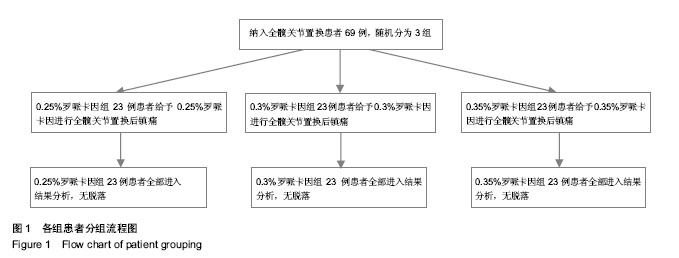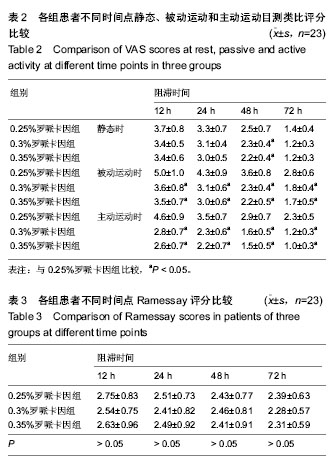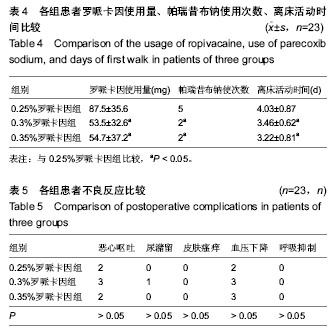中国组织工程研究 ›› 2015, Vol. 19 ›› Issue (13): 1995-1999.doi: 10.3969/j.issn.2095-4344.2015.13.006
• 人工假体 artificial prosthesis • 上一篇 下一篇
全髋关节置换后罗哌卡因的镇痛浓度
胡 北,陈 斌,陈 伟,纪韦韦
- 南京鼓楼医院集团宿迁市人民医院麻醉科,江苏省宿迁市 223800
Concentrations of ropivacaine for analgesia after total hip arthroplasty
Hu Bei, Chen Bin, Chen Wei, Ji Wei-wei
- Department of Anesthesiology, Suqian People’s Hospital, Drum Tower Hospital Group of Nanjing, Suqian 223800, Jiangsu Province, China
摘要:
背景:全髋关节置换后的剧烈疼痛是影响患者术后关节功能恢复最重要的因素之一,如何做到置换后良好的镇痛是目前研究的热点问题。 目的:探讨不同浓度罗哌卡因用于全髋关节置换后的镇痛效果。 方法:选取2012年1月至2014年6月于宿迁市人民医院骨外科行全髋关节置换的患者69例,ASA分级Ⅰ-Ⅲ级,采用随机数字表法分为0.25%罗哌卡因组、0.3%罗哌卡因组、0.35%罗哌卡因组,每组23例。置换结束后30 min,行罗哌卡因连续髂筋膜腔隙阻滞,开始各组注入相应浓度的罗哌卡因20 mL,随后接镇痛泵,无背景剂量,自控镇痛剂量为10 mL,时间60 min,持续72 h。于阻滞12,24,48和72 h时记录静息、被动运动和主动运动目测类比评分,静息目测类比评分≥ 4分时,静脉注射帕瑞昔布钠40 mg。记录阻滞后72 h内罗哌卡因用量、帕瑞昔布钠使用情况、离床时间及不良反应发生情况,同时评价患者镇静情况。 结果与结论:与0.25%罗哌卡因组患者比较,0.3%罗哌卡因组和0.35%罗哌卡因组患者静态时目测类比评分差异无显著性意义(P > 0.05),被动运动和主动运动目测类比评分均降低(P < 0.05),阻滞后72 h内罗哌卡因用量降低;与0.3%罗哌卡因组比较,0.35%罗哌卡因组静态时、被动运动和主动运动目测类比评分比较差异均无显著性意义(P > 0.05);0.3%罗哌卡因组和0.35%罗哌卡因组罗哌卡因用量比较差异无显著性意义(P > 0.05)。0.3%罗哌卡因组和0.35%罗哌卡因组帕瑞昔布钠使用率显著低于0.25%罗哌卡因组(P < 0.05),离床时间短于0.25%罗哌卡因组。并发症发生情况在3组间差异无显著性意义(P > 0.05)。提示3组不同浓度的哌罗卡因对全髋关节置换后患者均有一定的镇痛作用,且不良反应较少,其中0.3%的罗哌卡因是全髋关节置换后镇痛的适宜浓度,可减少哌罗卡因的使用量,并缩短患者离床时间。
中图分类号:



